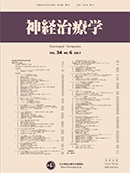Volume 37, Issue 1
Displaying 1-19 of 19 articles from this issue
- |<
- <
- 1
- >
- >|
-
2020Volume 37Issue 1 Pages 1
Published: 2020
Released on J-STAGE: July 21, 2020
Download PDF (194K)
-
2020Volume 37Issue 1 Pages 3
Published: 2020
Released on J-STAGE: July 21, 2020
Download PDF (217K) -
2020Volume 37Issue 1 Pages 4-9
Published: 2020
Released on J-STAGE: July 21, 2020
Download PDF (1209K) -
2020Volume 37Issue 1 Pages 10-15
Published: 2020
Released on J-STAGE: July 21, 2020
Download PDF (409K) -
2020Volume 37Issue 1 Pages 16-19
Published: 2020
Released on J-STAGE: July 21, 2020
Download PDF (1122K) -
2020Volume 37Issue 1 Pages 20-27
Published: 2020
Released on J-STAGE: July 21, 2020
Download PDF (573K) -
2020Volume 37Issue 1 Pages 28-31
Published: 2020
Released on J-STAGE: July 21, 2020
Download PDF (424K) -
2020Volume 37Issue 1 Pages 32-38
Published: 2020
Released on J-STAGE: July 21, 2020
Download PDF (507K)
-
2020Volume 37Issue 1 Pages 39-42
Published: 2020
Released on J-STAGE: July 21, 2020
Download PDF (1420K) -
2020Volume 37Issue 1 Pages 43-46
Published: 2020
Released on J-STAGE: July 21, 2020
Download PDF (460K) -
Effect of a balance adjustment system on gait disturbance in patients with neurodegenerative disease2020Volume 37Issue 1 Pages 47-50
Published: 2020
Released on J-STAGE: July 21, 2020
Download PDF (324K)
-
2020Volume 37Issue 1 Pages 51-52
Published: 2020
Released on J-STAGE: July 21, 2020
Download PDF (882K) -
2020Volume 37Issue 1 Pages 53-54
Published: 2020
Released on J-STAGE: July 21, 2020
Download PDF (1397K) -
2020Volume 37Issue 1 Pages 55-57
Published: 2020
Released on J-STAGE: July 21, 2020
Download PDF (1402K) -
2020Volume 37Issue 1 Pages 58-59
Published: 2020
Released on J-STAGE: July 21, 2020
Download PDF (629K)
-
2020Volume 37Issue 1 Pages 61-104
Published: 2020
Released on J-STAGE: July 21, 2020
Download PDF (8770K)
-
2020Volume 37Issue 1 Pages 105-108
Published: 2020
Released on J-STAGE: July 21, 2020
Download PDF (319K) -
2020Volume 37Issue 1 Pages 109
Published: 2020
Released on J-STAGE: July 21, 2020
Download PDF (144K) -
2020Volume 37Issue 1 Pages 110
Published: 2020
Released on J-STAGE: July 21, 2020
Download PDF (139K)
- |<
- <
- 1
- >
- >|
